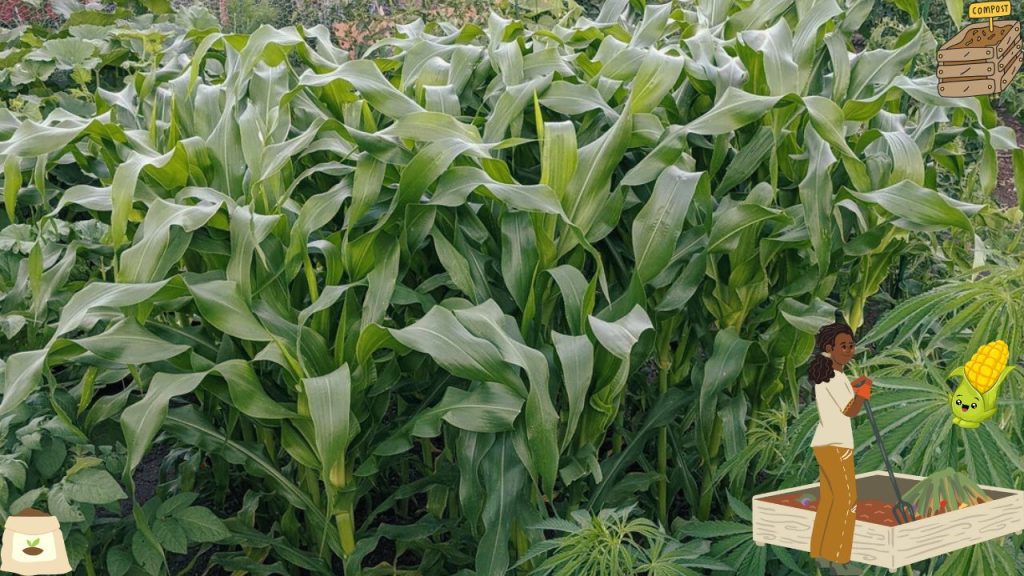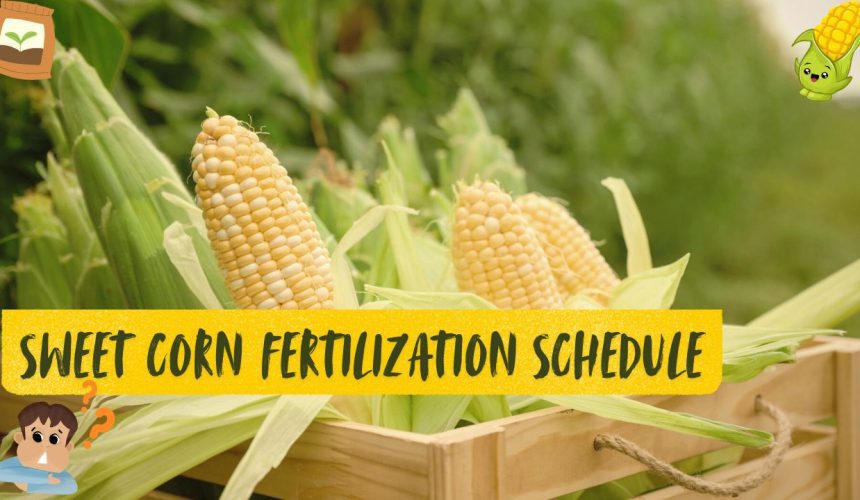Sweet Corn Fertilization Timing That Offers a Bigger Crop Yield
I remember my first attempt at growing corn. I had no idea about the corn fertilization schedule. The timing of those fertilizers makes all the difference in a bountiful harvest. So, I went to my friend and she told me everything about it which I’m going to share today.
As she said, you should fertilize your corn crop before planting, and follow up with a side-dressing application when the corn plants are 6-12 inches tall, typically at the 4-6 leaf stage, to meet the crop’s peak nitrogen demand during its early growth stages.
What Fertilizer Does Sweet Corn Need?
Corn fertilization requirements include several key nutrients for growth and optimal corn yield. The primary nutrients that corn needs are:
- Nitrogen (N): Nitrogen is essential for overall plant growth and is a critical component of chlorophyll, which is necessary for photosynthesis. Corn has a high demand for nitrogen. So, add nitrogen, particularly during the vegetative growth stage and early reproductive stages.
- Phosphorus (P): Phosphorus is essential for root development, energy transfer, and flower and fruit formation. Adequate phosphorus is crucial for strong root systems, which support corn plants throughout their growth cycle.
- Potassium (K): Potassium plays a vital role in regulating water uptake, improving drought tolerance, and elevating disease resistance. It also helps with overall plant well-being and nutrient uptake.
Additional Macronutrients For Corn Plant Growth
In addition to these primary macronutrients, corn also requires various micronutrients in smaller quantities. Some of the important micronutrients of corn include:
- Zinc (Zn): Zinc is essential for enzyme activity and is involved in the formation of growth hormones in plants. Zinc deficiency can result in stunted growth and reduced yield.
- Boron (B): Boron is necessary for flower formation and pollination. It also aids in the uptake of other nutrients. Boron deficiency can lead to poor kernel development.
- Iron (Fe), Manganese (Mn), Copper (Cu), and others: These micronutrients are required in small amounts but are still crucial for overall plant well-being and function. They play roles in various metabolic processes within the field corn plant.
The specific nutrient requirements for corn can vary depending on factors like soil type, previous nutrient levels, climate, and corn variety. It’s essential to perform a soil test to determine the current nutrient status of your soil and adjust your fertilization plan accordingly.
Here’s a simplified table of common corn fertilizers and their approximate per-acre requirements:
| Nutrient | Fertilizer Type | Approx. Requirement per Acre |
| Nitrogen (N) | Urea, Ammonium Nitrate | 150-200 lbs |
| Phosphorus (P) | Triple Superphosphate | 50-80 lbs |
| Potassium (K) | Potash (K2O) | 100-150 lbs |
| Micronutrients | Micronutrient Blend | Varies based on soil test |
When fertilizing corn, it’s important to choose the right type of liquid fertilizer with the appropriate N-P-K (nitrogen-phosphorus-potassium) ratio and micronutrient content to address any deficiencies identified in the soil test.
Properly timed and balanced fertilization can lead to productive corn plants and a better crop yield. You should prevent nitrogen loss for high-yielding corn uptake.
A to Z Corn Fertilization Schedule
Creating a comprehensive corn fertilization schedule is important for ensuring positive growth and maximizing yield. A well-thought-out schedule takes into account the nutrient needs of corn throughout its growth stages and addresses specific factors like soil conditions, climate, and the type of fertilizer used.
Here’s a short table outlining a simplified corn fertilizer schedule, including key growth stages and corresponding fertilizer applications:
| Growth Stage | Fertilizer Application |
| Pre-Planting | Incorporate NPK based on soil test results. |
| Early Vegetative Stage | Side-dress with nitrogen (N) when corn is 6-12 inches tall (4-6 leaf stage). |
| Late Vegetative Stage | Monitor crop nutrient needs. Consider additional N if required. |
| Reproductive Stage | Assess potassium (K) needs for grain fill, and apply if necessary. |
| Late-Season (optional) | Apply micronutrients or adjust based on leaf tissue testing. |

Below, I’ll provide an elaborative corn fertilization schedule with informative details:
Step 1: Pre-Planting Corn Growth Preparations
- Soil Testing: Begin by conducting a soil test at least a few months before planting. This analysis will determine the existing nutrient levels, pH, and any deficiencies in your soil.
- Nutrient Adjustment: Based on the soil test results, calculate the required amounts of nitrogen (N), phosphorus (P), potassium (K), and micronutrients. Adjust the fertilizer type and rate accordingly to meet these needs.
Step 2: Incorporating Corn Fertilizers into the Soil
- Before Planting: Apply a portion of the recommended fertilizers during soil preparation. You can either broadcast them evenly across the field or band them in rows where you’ll plant the corn.
- Starter Fertilizers: Some growers use starter fertilizers near the seed row during planting to provide an initial nutrient uptake for seedling corn plants. This can help ensure they have access to essential nutrients during early growth.
Step 3: Split Applications During the Corn Growing Season
- Pre-Planting: Apply a portion of the nitrogen fertilizer before planting, especially if using a slow-release or controlled-release nitrogen source.
- Side-Dressing: Apply additional nitrogen fertilizer when the corn plants are about 6-12 inches tall, typically at the 4-6 leaf stage. This helps meet the peak nitrogen demand during rapid vegetative growth.
- Late-Season Application: For some corn varieties and soil conditions, a late-season application of potassium may be necessary to support grain fill. Monitor the crop’s progress and nutrient uptake to determine if this is required.
Step 4: Consider Weather and Soil Conditions
- Weather Variability: Be aware of weather conditions, as heavy rainfall can lead to nutrient leaching. In such cases, you may need to adjust your fertilizer application rates.
- Soil Type: Different soil types have varying nutrient-holding capacities. Adjust your fertilization rates based on soil type to prevent over-fertilization or under-fertilization.
Step 5: Precision Application Techniques
- GPS Technology: Modern farming often utilizes GPS technology for precise fertilizer application. This ensures that fertilizers are distributed evenly and only where needed improving crop uptake.
- Variable Rate Application: Adjust fertilizer rates based on soil variability within your field. Soil maps and data can help you create a customized application plan.
Step 6: Monitoring and Assessing Corn Fertilization
- Nutrient Uptake: Monitor your corn grain growth and appearance. Yellowing leaves, stunted growth, or other signs of nutrient deficiency may indicate the need for adjustments.
- Leaf Tissue Testing: Periodically collect and analyze leaf tissue samples to assess nutrient levels within the plants. This can help fine-tune your fertilization approach.
Step 7: Potential Challenges and Solutions
- Nutrient Loss: Implement practices like cover cropping, reduced tillage, and controlled drainage systems to minimize nutrient loss through leaching and runoff.
- Nutrient Imbalances: Regularly assess nutrient levels and ratios in the soil to prevent imbalances that can affect crop yield.
Step 8: Organic and Sustainable Corn Fertilization Practices
- Consider organic matter, compost, and manure as sustainable alternatives to synthetic fertilizers.
- Practice crop rotation and cover cropping to improve soil fertility naturally.
Step 9: Late-Season Corn Plant Management
- As the corn growth reaches maturity and the grain fill stage, assess whether additional nutrient applications are required to support the final stages of development.
After the corn fertilizer recommendations and necessary steps, it’s time to discuss the facts you need to keep in mind. But before, why don’t you take a look at the useful vegetable gardening tips in your balcony.
Things to Consider About the Time of Sweet Corn Fertilization
Timing is dire when it comes to fertilizing sweet corn. Properly timed fertilizer applications can significantly impact the quality and yield of your sweet corn silage crop. Here are several important considerations regarding the timing of sweet corn fertilization:
Corn Growth Stage
- Pre-Planting: Before planting sweet corn, it’s essential to incorporate fertilizers into the soil based on soil test results. This provides a foundational nutrient base for the crop.
- Early Growth: Sweet corn has high nitrogen requirements during the early vegetative growth stage. A side-dressing of nitrogen is often recommended when the corn plants are 6-12 inches tall, usually at the 4-6 leaf stage. This is when the crop has an increased demand for nitrogen to support leaf and stalk development.
- Later Growth: Monitor the growth of your sweet corn and assess nutrient needs as it progresses. Some late-season applications of potassium may be necessary to support grain fill and fruit development.
Soil Temperature
Fertilizer uptake by corn plants is influenced by soil temperature. It’s generally more effective to apply fertilizers when the soil has warmed up to a certain degree. Cool soil temperatures can limit nutrient availability to the plants.
Typically, you should aim to apply fertilizers when soil temperatures are consistently above 50°F (10°C) for optimal uptake.
Weather Conditions
Be mindful of weather conditions when planning fertilizer applications. Heavy rainfall immediately after fertilization can lead to nutrient leaching, which can result in nutrient loss.
It’s best to apply fertilizers when rain is not expected within the next 24-48 hours, allowing time for plants to take up nutrients.
Nitrogen Release Rates
If you’re using slow-release or controlled-release nitrogen fertilizers, be aware of their release rates. These fertilizers are designed to provide a sustained supply of nitrogen over time.
Adjust your fertilizer application timing to ensure that the release of nutrients aligns with the corn plant’s growth stages and nutrient demands.
Soil Testing
Conduct soil tests well in advance of planting to determine the nutrient content and pH of your soil. The results of the soil test will guide your fertilizer choices and application rates. Regular soil testing allows you to fine-tune your fertilization schedule each growing season.
Grow Corn Variety-Specific Timing
Different sweet corn varieties may have varying nutrient requirements and growth patterns. Consult the specific recommendations for the sweet corn variety you are planting to ensure that your fertilization timing aligns with its needs.
Environmental Factors
Factors like altitude, latitude, and local climate can influence the timing of sweet corn fertilization. Colder regions may have a shorter growing season, necessitating adjustments to the fertilization schedule.
Monitoring and Adjustments
Continuously monitor your sweet corn crop’s growth throughout the season. Visual cues, like leaf color and plant size, can provide insights into nutrient deficiencies or excesses. Be prepared to make adjustments to your fertilization plan if needed.
Late-Season Management
As your sweet corn nears maturity and the ears begin to fill out, assess whether additional nutrient applications are required to support the final stages of fruit development and quality.

When Is It Too Late To Fertilize Corn Plant?
It’s essential to apply fertilizer to corn at the right time to maximize its effectiveness and promote growth. While there isn’t an exact cutoff date for fertilizing corn, there are guidelines to consider.
Typically, it’s considered too late to fertilize corn when the crop has reached its reproductive or grain-fill stage. Corn’s nutrient requirements shift as it transitions from vegetative growth to reproduction.
Fertilizing too late during the grain-fill stage can be less effective because most of the plant’s energy is directed toward grain development rather than vegetative growth. To determine the optimal timing for fertilization, monitor the corn’s growth stage and nutrient needs throughout the season.
Early to mid-vegetative stages are ideal for providing nitrogen and other essential nutrients. As the corn enters the reproductive phase, it’s best to avoid further fertilization unless specific nutrient deficiencies are identified.
Always base your corn fertilization schedule on soil tests and growth stages to avoid late-season applications that may not benefit the crop.
FAQs
Is there a specific soil temperature I should consider when fertilizing corn?
Yes, aim to apply fertilizers when the soil consistently reaches above 50°F (10°C). Cooler soil temperatures can limit nutrient uptake by the corn plants, so waiting for warmer soil is advisable.
Can I use organic fertilizers for corn, and how should I adjust my corn fertilization schedule?
Yes, organic fertilizers like compost or manure can be used. Adjust your schedule by applying them well in advance to allow time for decomposition. Consider cover cropping and crop rotation for long-term soil improvement with organics.
Are there differences in fertilization schedules for different corn varieties?
Yes, different corn varieties may have varying nutrient requirements and growth patterns. Consult specific recommendations or guidelines for the variety you are planting to ensure your corn fertilization schedule aligns with its needs.
Thank you for staying with us. If you have more inquiries related to corn plants like whether it’s good to use 16-16-8 Liquid fertilizer or not.





